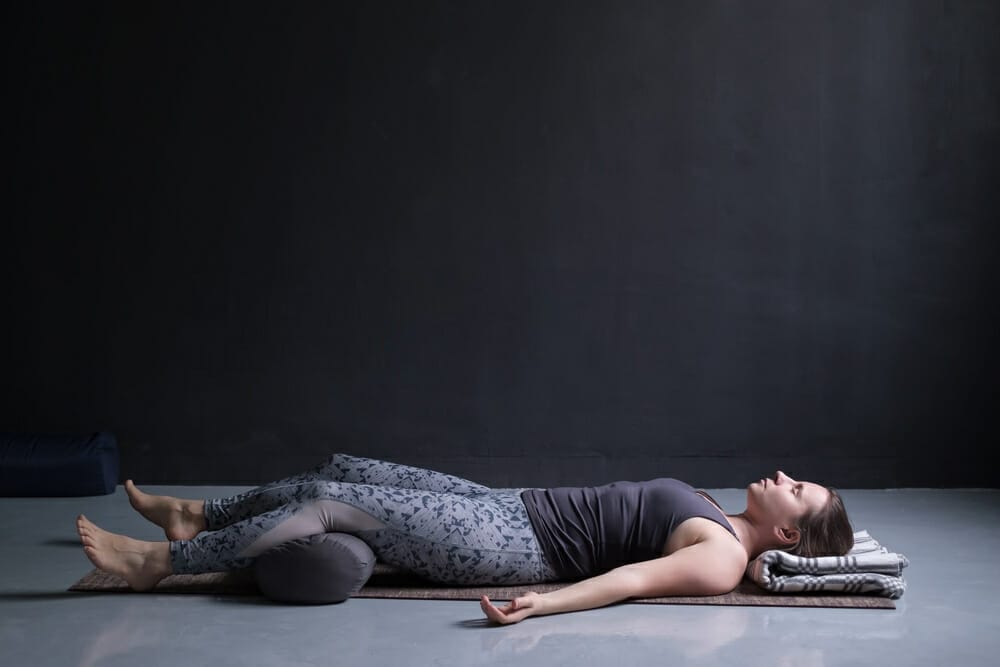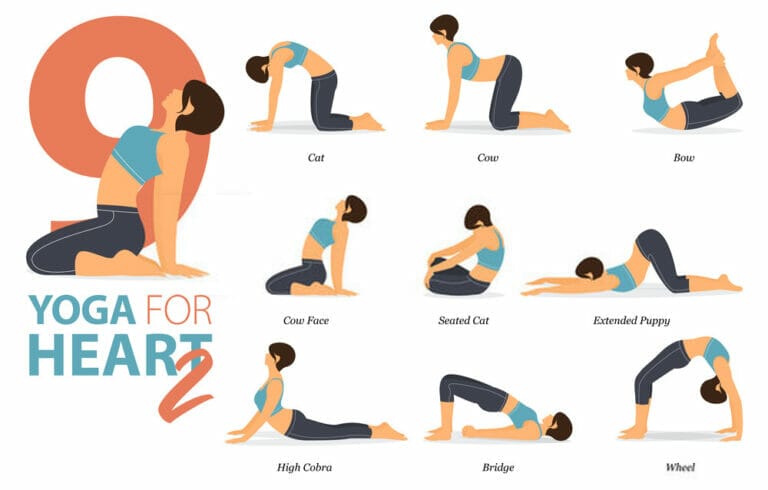Vagus Nerve Yoga Poses
Did you know that activating the vagus nerve regulates your immune system and releases various hormones and neurotransmitters, including acetylcholine and oxytocin?
Consequently, inflammation reduces, allergies lessen, tension headaches are relieved, memory improves, and you may experience sensations of relaxation.
Traditional vagus nerve stimulation (VNS) therapy, also known as neuromodulation, entails surgically implanting a bio-electronic device that stimulates the vagus nerve.
It is, nevertheless, possible to naturally activate your vagus nerve.
Yoga poses, for example, increase vagal tone, which results in natural therapy. Therefore, anyone can train to be consciously aware of the vagus nerve and use this innate ability to reduce pain and stress.
So what is the vagus nerve?
The vagus nerve originates in the brain stem. It travels through the face, neck, lungs, heart, diaphragm, and abdomen, including the stomach, spleen, intestines, colon, liver, and kidneys, the tenth cranial nerve.
Vagus is Latin for "wanderer," a fitting title for the body's longest cranial nerve. The vagus nerve is intimately linked to mood, immunity, digestion, and heart rate.
The vagus nerve is dual, meaning it has both sensory and motor components.
The vagus nerve stimulates the parasympathetic nervous system, which governs the body's resting state known as the "rest and digest" or "feed and breed" response.
The body conserves energy by slowing down breathing, reducing heart rate, and releasing relaxing hormones to stimulate digestion in this physiological state.
The vagus nerve also regulates body functions during periods of stress, such as fight-or-flight response.
The objective of a vagus nerve yoga practice is to increase neural system flexibility, not physical flexibility.
Yoga has significant advantages for enhanced vagal tone, stress reduction, and trauma healing in studies.
It will assist you in becoming more proficient at transitioning between the sympathetic and parasympathetic neural systems with more comfort and flexibility.
The following seven vagus nerve yoga techniques can help you build a healthy vagal tone, recover equilibrium in your life, and revitalize as needed:
Conscious Breathing:
The breath is the quickest way to alter the balance of sympathetic and parasympathetic nervous system activities. Slow, rhythmic diaphragmatic breathing improves healthy vagal tone.

- Ujjayi pranayama is a type of yogic breathing that involves activating your whisper muscles to generate a slight constriction in the back of the throat.
- Exhale out of your mouth as if you were fogging up a mirror to understand this breath.
- Breathe normally now, but seal your mouth and exhale via your nose. You’ll notice that the sound of your breath has become more robust, resembling ocean waves.
- Begin by counting your inhalations and exhalations on an even scale. For example, inhale to the count of four and exhale to the count of four.
- To achieve even more profound relaxation, progressively lengthen your expiration in comparison to your inhale. Start with a four-count on inhaling and work your way to a 6 or 8 count on the exhalation.
Half-Smile:
A “half-smile” is an effective method to shift your mental state and create a calm mood in the present moment.
The vagus nerve reaches into the muscles of the face that relaxes the muscles the face. It, then slightly turn up your lips that will enhance the vagal tone- this exercise activates the “social nervous system,” the most developed branch of the vagus nerve.
Imagine your jaw relaxing as you smile and a sense of relaxation spreading through your face, head, and shoulders. Keep an eye out for small shifts in the quality of your thoughts and feelings.
Wake Up and Stretch:
Yoga may give a mild pick-me-up for your mind and body if you have trouble waking up in the morning or are weary and sluggish in the afternoon.

Try standing postures like Virabhadrasana I, II, or III (Warrior Poses I, II, or III). Keep your feet connected to the earth to stay grounded and healthily fuel yourself.
Allow your breath to remain rhythmic so that you stay rooted and related to your body’s sensations.
Open Your Heart:
Yoga poses that open across your chest and neck gently activate the vagus nerve. For example, try this heart-opening sitting meditation:
- Bring your hands to your shoulders and hold them there.
- Inhale as you extend your elbows wide, elevate your chin, and expand across the front of your chest.
- Exhale as you tuck your chin and contract your elbows in front of your heart.
- In this flowing meditation, take many deep breaths. In this breathing pattern, concentrating on your inhale may be both exciting and uplifting. Allow yourself to expand into the open heart.
Release the Belly:
You may work with the vagus nerve’s link as it goes through your stomach.

- With your hands behind your shoulders and your knees beneath your hips, enter Bharmanasana (Tabletop Pose). You can put a folded blanket below you if your knees are bothering you.
- As you inhale, lift your head and hips, dropping your belly to the floor and moving into Bitilasana (Cow Pose).
- Lower your head and hips while lifting your spine into Marjaryasana on an exhale (Cat Pose). With your breath, find your movement timing.
- Repeat as necessary to provide a gentle massage for your stomach and spine.
Self-Compassion Meditation:
Self-compassion and the practice of “lovingkindness” encourage you to treat yourself and others with kindness.
According to research, individuals who practice lovingkindness meditation have a higher vagal tone, more autonomic flexibility, a stronger feeling of social connectivity, and more pleasant emotions.
- Take a minute to think about a problem you’re dealing with in your life.
- Consider someone else who you know has a similar problem. Can you elicit feelings of sympathy or kindness in this person?
- Take note of how compassion makes you feel in your body.
- Check to see whether you can apply the same lovingkindness to yourself.
Yoga Nidra:
Slowing down and calming the nervous system can be achieved through restorative yoga. Yoga Nidra, often known as “yogic sleep” or “relaxation meditation,” is a well-known technique.

Yoga Nidra is the cure to our hectic, contemporary existence, and it allows you to access the parasympathetic nervous system to heal your body and mind.
- Lie down on the floor, on a blanket, or a yoga mat in a relaxed position.
- Develop a sense of body and breath awareness. Allow yourself to experience whatever comes up, including any places of tension, heaviness, or tightness.
- Allow yourself 30 minutes of complete stillness for a wonderfully soothing and nourishing experience.
Benefits of Stimulating the Vagus Nerve
You may control both sympathetic hyperarousal and parasympathetic hyperarousal by stimulating the vagus nerve. However, all vagus nerve stimulation triggers a relaxation response.
Therefore, it's critical to build a tolerance for the parasympathetic state without falling into dysfunctional hyperarousal.
When you first start exploring relaxation, you might feel sleepy. Meditation and Yoga Nidra may be highly soothing; yet, some people fall asleep during these activities. The ultimate objective is to achieve a calm yet alert condition.
However, you may try allowing yourself to sleep, which could be therapeutic for your nervous system.
On the other hand, if you start to feel dizzy or nauseous after doing any vagus nerve treatments, back off and begin slowly and softly with only a few minutes each day.
Bottom Line
The vagus nerve is of critical importance for controlling your parasympathetic nervous system. Therefore, it can be used to control both sympathetic hyperarousal and parasympathetic hyperarousal.
In addition, the body's ability to get into a more relaxed state is enhanced by stimulating the vagus nerve.
The above interventions are only a few options for doing so. Whether you choose meditation, yoga, or other techniques, it’s important to practice regularly and note your progress.
Be sure to bring a healthy and happy attitude, and remember that it is essential to take time for yourself.
It is beneficial for you and those around you who will benefit from your improved aura and overall health.








Your article on appreciating and healthily stimulating or regulating the Polyvagal system is one of the most practical I’ve read. There is much to understand, and after damage to my vagus nerve during a 2014 surgery I’ve been studying Polyvagal Nerve theory. Your article offers practical healing suggestions that don’t require a medical degree to access self-help and I am grateful for that.
Thank you,
Jan
Glad I could be of help